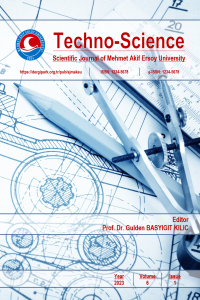Abstract
References
- Piecyk, M.I., McKinnon, A.C. (2010). Forecasting the carbon footprint of road freight transport in 2020. Int. J. Production Economics, Vol. 128, p. 31-42.
- Kannan, D., Diabat, A., Alrefaei, M., Govindan, K., Yong, G. (2012). A carbon footprint-based reverse logistics network design model. Resources, Conservation and Recycling, Vol. 67, p. 75-79.
- Cansız, Ö.F., Ünsalan, K. (2020). Yük Taşımacılığında Tek Türlü ve Çok Türlü Taşımacılık Rotalarının Karbon Ayak İzinin Karşılaştırılması. DÜMF Mühendislik Dergisi, Vol. 11, No. 2, p. 809-816.
- Bıyık, Y., Civelekoğlu, G. (2020). Isparta İlinde Karayolu Kaynaklı Karbon Ayak İzinin Hesaplanması. Bilge International Journal of Science and Technology Research, Vol. 4, No. 2, p. 78-87.
- Bıyık, Y., Civelekoğlu, G. (2018). Ulaşım Sektöründen Kaynaklı Karbon Ayak İzi Değişiminin İncelenmesi. Bilge International Journal of Science and Technology Research, Vol. 2, No. 2, p. 157-166.
Abstract
Today, approximately 95% of the energy consumed for transportation all over the world is met by engines using hydrocarbon fuels. Accordingly, approximately 20% of global greenhouse gases are produced by the combustion of fuels used in transportation. CO2, CH4 and N2O are the most important greenhouse gas emissions from transportation. The identification, monitoring, control and reduction of greenhouse gases from transportation have a significant impact on global climate change. In this study, the greenhouse gas emissions from transportation in Turkey were evaluated. For this purpose, greenhouse gas emissions measured between 1990-2019 were used. Emission values are taken from the data of the Turkish Statistical Institute (TUIK). CO2 emissions from transportation in Turkey have increased every year since 1990. CH4 emissions from transportation have increased since 2000 and have recently reached their highest values. N2O emissions from transportation showed a small increase, and followed a stagnant course for long years.
References
- Piecyk, M.I., McKinnon, A.C. (2010). Forecasting the carbon footprint of road freight transport in 2020. Int. J. Production Economics, Vol. 128, p. 31-42.
- Kannan, D., Diabat, A., Alrefaei, M., Govindan, K., Yong, G. (2012). A carbon footprint-based reverse logistics network design model. Resources, Conservation and Recycling, Vol. 67, p. 75-79.
- Cansız, Ö.F., Ünsalan, K. (2020). Yük Taşımacılığında Tek Türlü ve Çok Türlü Taşımacılık Rotalarının Karbon Ayak İzinin Karşılaştırılması. DÜMF Mühendislik Dergisi, Vol. 11, No. 2, p. 809-816.
- Bıyık, Y., Civelekoğlu, G. (2020). Isparta İlinde Karayolu Kaynaklı Karbon Ayak İzinin Hesaplanması. Bilge International Journal of Science and Technology Research, Vol. 4, No. 2, p. 78-87.
- Bıyık, Y., Civelekoğlu, G. (2018). Ulaşım Sektöründen Kaynaklı Karbon Ayak İzi Değişiminin İncelenmesi. Bilge International Journal of Science and Technology Research, Vol. 2, No. 2, p. 157-166.
Details
| Primary Language | English |
|---|---|
| Subjects | Electrical Energy Storage |
| Journal Section | Original Research Articles |
| Authors | |
| Publication Date | July 3, 2023 |
| Acceptance Date | July 2, 2023 |
| Published in Issue | Year 2023 Volume: 6 Issue: 1 |


